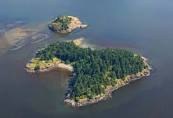
Trip
Sea Kayak - Saddlebag Island
This 8 mile paddle is designed as an Everett Basic Student qualifying paddle. Wet exits and assisted rescues will be practiced by all participants. We will launch from Seafarers Memorial Park, paddle around Hat Island, lunch at Saddlebag, around Huckleberry and return to Seafarers.
- Sat, May 12, 2018
- Everett Sea Kayaking Committee
- Sea Kayaking
- Adults
- Sea Kayak II
- Easy
- Mileage: 8.0 nm
- Maximum Wind: 10 kts
- Maximum Currents: 1.0 kts
- Pace: 2.0 kn
- FULL (6 capacity)
- FULL (3 capacity)
- Cancellation & Refund Policy
Seafarers' Memorial Park, Anacortes 8:45 AM arrival, Prelaunch talk at 9:45 AM. Launch by 10 AM.
Directions to Seafarers' Memorial Park: Entering Anacortes turn right onto R Street (1/4 mi. prior to Commercial). Continue onto Q. Right onto Seafarers' Way.
This is a 3-4 hour paddle with a 45 minute lunch stop at Saddlebag Island. Plan on returning to Seafarers' Memorial Park on or about 3 pm.
All participants will participate in wet exits and assisted rescues. Sea Kayaking Essentials will be spot checked.
Be sure to check tide tables ahead of time and come prepared with that information.
I expect this sea kayak trip to have this difficulty and plan to paddle in up to these conditions (view the sea kayak difficulties definitions on our Activity Types, Difficulties & Prerequisites page):
- Difficulty: SK II/III
- Wind: <10 mph
- Waves: < 1'
- Currents: 1 kn
- Distance: 8 nm
- Pace: 2.5 nm
Padilla Bay & Nearby Islands
-
Sea Trails Rosario Strait Bellingham WA001
Sea Trails Lummi Island, Bellingham & Samish Bays WA005
NOAA Bellingham to Everett No. 18423
NOAA Strait of Juan de Fuca to Strait of Georgia No. 18421
MapTech The San Juan Islands No. 104
MapTech Rosario Strait No. 106 - See full route/place details.
Required Equipment
These seven essentials plus The Ten Essentials are required on all sea kayaking trips. All but the whistle and clothing should be provided with any kayak rental.
- Floatation in both ends of the kayak
- U.S. Coast Guard approved Personal Flotation Device (PFD)
- Paddle
- Spray skirt
- Bilge pump with floatation
- Self-rescue paddle float
- Waterproof whistle
- Appropriate clothing for the conditions encountered seasonally
- Spare clothing in a dry bag
- Navigation (chart, compass - deck or orienteering type)
- Water
- Food
- First aid supplies
- Sun protection (sun screen, hat, sunglasses with retainer strap)
- Flashlight or headlamp
- Duct Tape
